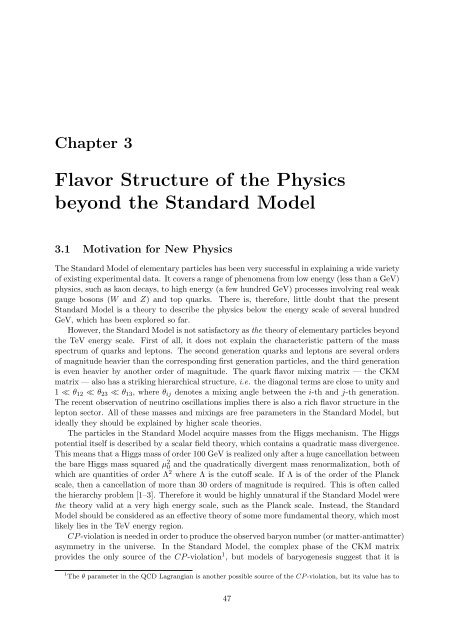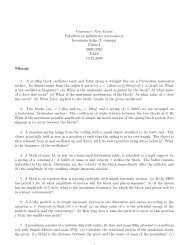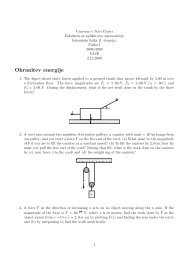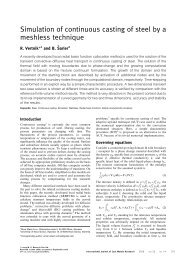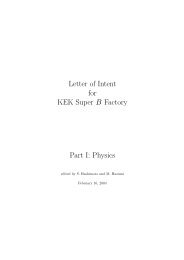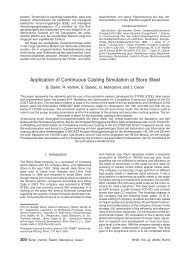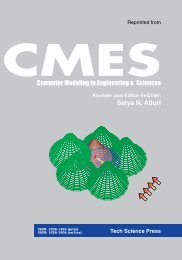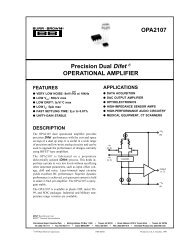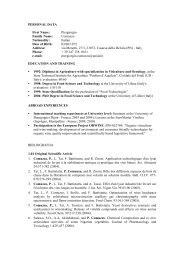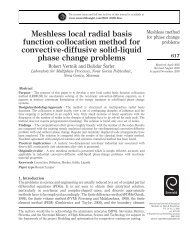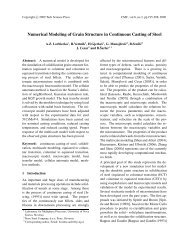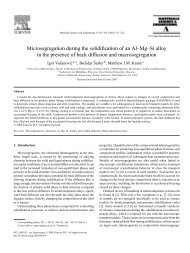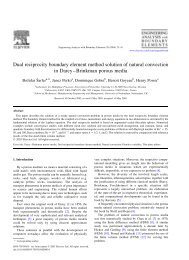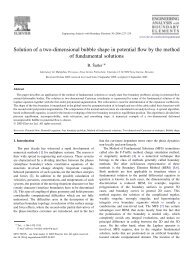Letter of Intent for KEK Super B Factory Part I: Physics
Letter of Intent for KEK Super B Factory Part I: Physics
Letter of Intent for KEK Super B Factory Part I: Physics
You also want an ePaper? Increase the reach of your titles
YUMPU automatically turns print PDFs into web optimized ePapers that Google loves.
Chapter 3<br />
Flavor Structure <strong>of</strong> the <strong>Physics</strong><br />
beyond the Standard Model<br />
3.1 Motivation <strong>for</strong> New <strong>Physics</strong><br />
The Standard Model <strong>of</strong> elementary particles has been very successful in explaining a wide variety<br />
<strong>of</strong> existing experimental data. It covers a range <strong>of</strong> phenomena from low energy (less than a GeV)<br />
physics, such as kaon decays, to high energy (a few hundred GeV) processes involving real weak<br />
gauge bosons (W and Z) and top quarks. There is, there<strong>for</strong>e, little doubt that the present<br />
Standard Model is a theory to describe the physics below the energy scale <strong>of</strong> several hundred<br />
GeV, which has been explored so far.<br />
However, the Standard Model is not satisfactory as the theory <strong>of</strong> elementary particles beyond<br />
the TeV energy scale. First <strong>of</strong> all, it does not explain the characteristic pattern <strong>of</strong> the mass<br />
spectrum <strong>of</strong> quarks and leptons. The second generation quarks and leptons are several orders<br />
<strong>of</strong> magnitude heavier than the corresponding first generation particles, and the third generation<br />
is even heavier by another order <strong>of</strong> magnitude. The quark flavor mixing matrix — the CKM<br />
matrix — also has a striking hierarchical structure, i.e. the diagonal terms are close to unity and<br />
1 ≪ θ12 ≪ θ23 ≪ θ13, where θij denotes a mixing angle between the i-th and j-th generation.<br />
The recent observation <strong>of</strong> neutrino oscillations implies there is also a rich flavor structure in the<br />
lepton sector. All <strong>of</strong> these masses and mixings are free parameters in the Standard Model, but<br />
ideally they should be explained by higher scale theories.<br />
The particles in the Standard Model acquire masses from the Higgs mechanism. The Higgs<br />
potential itself is described by a scalar field theory, which contains a quadratic mass divergence.<br />
This means that a Higgs mass <strong>of</strong> order 100 GeV is realized only after a huge cancellation between<br />
the bare Higgs mass squared µ 2 0<br />
and the quadratically divergent mass renormalization, both <strong>of</strong><br />
which are quantities <strong>of</strong> order Λ 2 where Λ is the cut<strong>of</strong>f scale. If Λ is <strong>of</strong> the order <strong>of</strong> the Planck<br />
scale, then a cancellation <strong>of</strong> more than 30 orders <strong>of</strong> magnitude is required. This is <strong>of</strong>ten called<br />
the hierarchy problem [1–3]. There<strong>for</strong>e it would be highly unnatural if the Standard Model were<br />
the theory valid at a very high energy scale, such as the Planck scale. Instead, the Standard<br />
Model should be considered as an effective theory <strong>of</strong> some more fundamental theory, which most<br />
likely lies in the TeV energy region.<br />
CP -violation is needed in order to produce the observed baryon number (or matter-antimatter)<br />
asymmetry in the universe. In the Standard Model, the complex phase <strong>of</strong> the CKM matrix<br />
provides the only source <strong>of</strong> the CP -violation 1 , but models <strong>of</strong> baryogenesis suggest that it is<br />
1 The θ parameter in the QCD Lagrangian is another possible source <strong>of</strong> the CP -violation, but its value has to<br />
47


